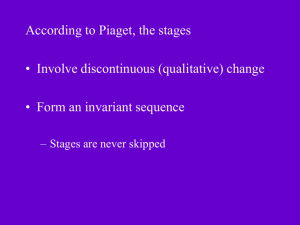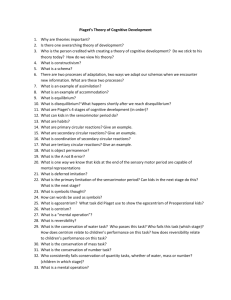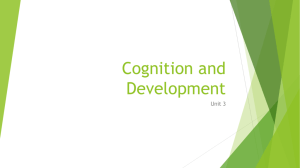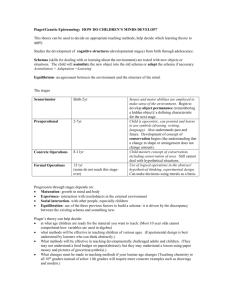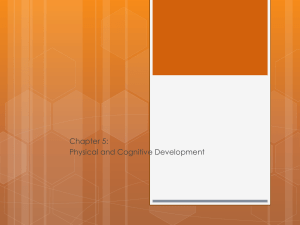Gender _ Piaget JC
advertisement
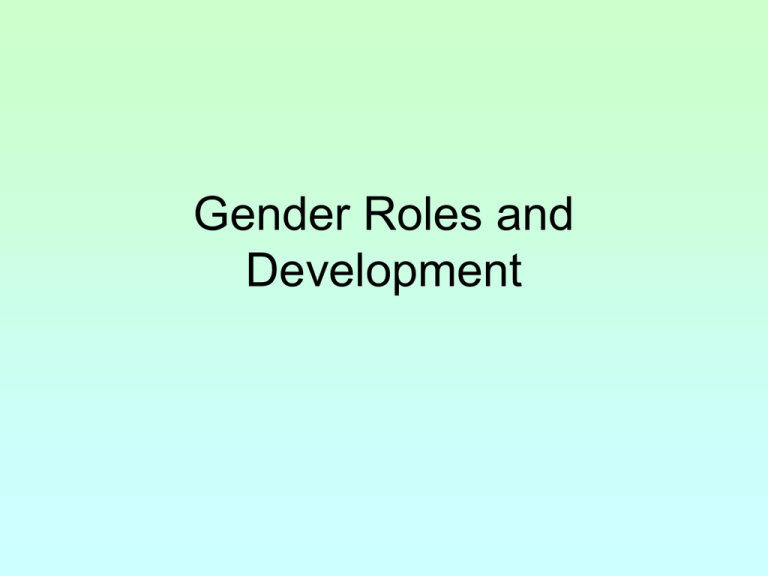
Gender Roles and Development Gender • As we talked about before, “gender” refers to the cultural and social meanings that are associated with maleness and femaleness. Gender Roles • Behaviors and traits that culture designates are male or female • Examples? Gender Identity • A person’s psychological sense of being male or female • Between 2-3 years, a child can identify themselves as either boy or girl – However, they only can categorize this by hairstyle, clothing, and activities Dolls • What gender? • Why? Trucks, dirt, aggression • What gender? • Why? Social Worlds • • • • Girls play with other girls Boys play with other boys They find the other gender “icky” Boys are far more rigid in their stereotypes – Is this true even as they get older? Social Learning Theory • Posits that gender roles are learned through reinforcement, punishment, and modeling • How might that work? But… • They found that parental reinforcement really only plays a small role—parents treat their boys and girls rather similarly. Soo… what’s the dealio? • Books • Television • Observation of role models Gender Schema Theory • Children actively develop mental categories for masculinity and femininity. • “Trucks are for boys and dolls are for girls.” • Tend to make students like their own gender better • Labeling objects as boy or girl objects completely influenced their memory and perception of the object Cognitive Development in Infancy and Childhood: Piaget’s Cognitive Stages Question to ponder Do Kids think differently than adults? Do freshmen think differently than Seniors? Piaget’s Theory of Cognitive Development • Jean Piaget (1896–1980) Swiss psychologist who became leading theorist in 1930’s • Piaget believed that “children are active thinkers, constantly trying to construct more advanced understandings of the world” • These “understandings” are in the form of structures he called schemas Piaget’s Approach • Primary method was to ask children to solve problems and to question them about the reasoning behind their solutions • Discovered that children think in radically different ways than adults • Proposed that development occurs as a series of ‘stages’ differing in how the world is understood Cognition • All the mental activities associated with thinking, knowing, and remembering • Children think differently than adults Stage 1- Sensorimotor Stage • From birth to about age two • Child gathers information about the world through senses and motor functions • Child learns object permanence Sensorimotor Stage (birth – 2) • Information is gained through the senses and motor actions • In this stage child perceives and manipulates but does not reason • Symbols become internalized through language development • Object permanence is acquired Object Permanence • The understanding that objects exist independent of one’s actions or perceptions of them • Before 6 months infants act as if objects removed from sight cease to exist – Can be surprised by disappearance/reappearance of a face (peek-a-boo) Object Permanence • The awareness that things continue to exist even when they cannot be sensed • “Out of sight, out of mind” Object Permanence Stage 2- Preoperational Stage • From about age 2 to age 6 or 7 • Children can understand language but not logic • Fantasy Play Preoperational 1. Symbolic functioning – is that a child uses to represent something that is not physically present like the use of mental symbols, words, or pictures Find the two doors that are alike Preoperational - Egocentrism • The child’s inability to take another person’s point of view • Includes a child’s ability to understand that symbols can represent other objects Conservation • An understanding that certain properties remain constant despite changes in their form • The properties can include mass, volume, and numbers. Conservation Conservation Conservation Conservation • Number In conservation of number tests, two equivalent rows of coins are placed side by side and the child says that there is the same number in each row. Then one row is spread apart and the child is again asked if there is the same number in each. Conservation • Length In conservation of length tests, two same-length sticks are placed side by side and the child says that they are the same length. Then one is moved and the child is again asked if they are the same length. Conservation • Substance In conservation of substance tests, two identical amounts of clay are rolled into similar-appearing balls and the child says that they both have the same amount of clay. Then one ball is rolled out and the child is again asked if they have the same amount. • http://www.youtube.com/watch?v=TRF27F 2bn-A Concrete Operational Stage (7–12 years) • Understanding of mental operations leading to increasingly logical thought • Classification and categorization • Less egocentric • Inability to reason abstractly or hypothetically Concrete operational 1. Decentering – this is where a child considers all aspects of a problem to solve it 2. Elimination of egocentrism – kids can begin to see the others point of view Formal Operational Stage (age 12 – adulthood) • Hypothetico-deductive reasoning • Adolescent egocentrism illustrated by the phenomenon of personal fable and imaginary audience Stage 4- Formal Operational Stage • Child can think logically and in the abstract • Can solve hypothetical problems (What if…. problems) Critique of Piaget’s Theory • Underestimates children’s abilities • Overestimates age differences in thinking • Vagueness about the process of change • Underestimates the role of the social environment • Lack of evidence for qualitatively different stages Vygotsky’s Sociocultural Perspective • Vygotsky—children learn from interactions with other people – Zone of proximal development—what a child can do by interacting with another person, but can’t do alone. – Critical thinking based on dialogue with others who challenge ideas • Piaget—focused on children’s interaction with the physical world Scenarios • Although the parents spent $300 on holiday toys for their 1-year old daughter, she spent more time playing peekaboo by sticking her head in and out of the box that one of the toys came in. Why should the parents have kept their money? • • • • What activity might interest a 1 year old? A 5 year old? A 9 year old? Is there anything that might interest them all at once?
